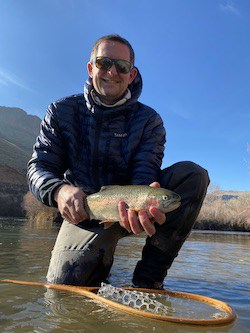Fly Fishing For Suckers
June 25th, 2022
Suckers are a blast to chase on the fly, and yet they’re a vastly overlooked species. Considered “rough fish,” they’re despised by many, and avoided by nearly everyone.
They’re definitely a unique looking fish, and they’re challenging to catch on a fly. You not only need to have patience and persistence, but your casts must be laser accurate.
I’ve caught plenty of suckers on flies, including some of near-record size. In the below article, I’ll share with you all my techniques and tactics for hooking into them, including plenty of pictures and videos.

World Record Sucker
In the above picture, I’m releasing a monster largescale sucker (Catostomus macrocheilus) I caught on a crayfish fly pattern. I didn’t measure or weigh this fish, but I’d estimate is was 24-inches long and between 7-8 pounds.
I later learned that the IGFA all tackle world record is just 3lbs 11oz (caught in Montana). The catch-and-release record is 9lbs and 27.7-inches long. So, the suckers I caught aren’t too far from the record.
Here’s a video showing a big largescale sucker as I bring it to the net after hooking it on a weighted fly. I’ll share my technique in a subsequent section.
Facts About Suckers
Believe it or not, suckers aren’t an invasive species. In fact, there are around 80 species of fish in the sucker family (Catostomidae), and 78 of them are only found in North America.
Research has also shown that suckers aren’t destructive fish that consume massive numbers of gamefish eggs. This is a myth passed down by anglers from generation to generation. My personal opinion is that their suction cup mouths remind people of carp.
Ever wonder why state fisheries release tiger muskies (a sterile hybrid between a musky and a northern pike) into local waters? It’s not for sportfishing opportunities–it’s because the muskies target suckers. Put another way, it’s an attempt to eradicate suckers.
Most suckers spawn in the spring in shallow water shoals with sand or gravel bottoms. They can be found in lakes, rivers, streams, and ponds. They can lay voluminous numbers of eggs (sometimes over 20,000), which are adhesive and stick to the substrate.
Some of the most commonly seen species of sucker are mountain (Catostomus platyrhynchus), largescale (Catostomus macrocheilus), longnose (Catostomus catostomus), white (Catostomus commersonii), and buffalo (Ictiobus cyprinellus).
Here’s a big largescale sucker I landed. I was able to watch this fish vacuum-up my fly. How do you not love that mouth?

Fly Fishing for Suckers
Dry Fly Angling
I won’t sugar-coat it. If you ever catch a sucker on a dry fly, consider it one of your greatest fly fishing achievements.
These fish stay almost glued to the bottom of the lake, river, or canal. In all seriousness, they almost appear to suction themselves to rocks with their mouths. In fact, I think that’s actually what they’re doing.
In other words, suckers aren’t surface feeders. I don’t like saying it, but it’s probably a waste of your time trying to lure them in with dry flies.
If you’re focused on catching big rough fish on dries, check out my article on fly fishing for carp.
Tossing Streamers
Weighted streamers are the fly patterns I’ve always used to catch suckers. Nothing else has worked nearly as well.
Specifically, I favor conehead and beadhead streamers in sizes 4-8. If you’re so inclined, you can buy some of the same patterns I’ve used successfully on this page at Amazon.
I haven’t found that color is a critical factor, but they do seem to favor black and brown.
Now, I don’t cast and strip the streamer back towards me. That won’t work 99% of the time. Suckers will occasionally chase a stripped fly or drifiting nymph, I’ve seen it happen, but they almost always turn-away shortly thereafter.
Sight-fishing is the the way to go. Wait until you spot a sucker, and then cast to that specific fish. They’ll often be foraging on the bottom.
You want your fly to land a few inches in front of them, anticipating their forward path. Give your fly some action as the fish approaches.
Now, watch it’s mouth. Suckers will extend their mouths as they suck-up your fly pattern. When you see this occur, quickly set the hook. Don’t delay, because they’ll spit out your fly once they realize it’s not edible.
Big suckers put up a nice fight. It might surprise you to learn that I’ve had several suckers take out 75% of my fly line on their initial long runs (fly line is usually 100 feet long), almost putting me into my backing. They’ve earned my respect, and I relish catching them.

Summary
Suckers are categorized as rough fish, and because of this there are no seasons or regulations protecting them. But, things are changing in sportfishing. Carp were once shunned as “trash fish” or “junk fish,” but are now embraced as worthy fly quarry.
So, don’t rule out the fun you can have stalking your local canals, ponds, and rivers. Suckers are populate many bodies of water, even if you don’t notice them. Keep your eyes peeled, especially during spawning season when they congregate.
If you’re up to the challenge, grab your gear and find some suckers. They’re a rewarding fish to catch on a fly.

About the Author
My name's Sam and I'm a fly fishing enthusiast just like you. I get out onto the water 80+ times each year, whether it's blazing hot or snow is falling. I enjoy chasing everything from brown trout to snook, and exploring new waters is something I savor. My goal is to discover something new each time I hit the water. Along those lines, I record everything I learn in my fly fishing journal so I can share it with you.
Follow me on Instagram , YouTube, and Facebook to see pictures and videos of my catches and other fishing adventures!


